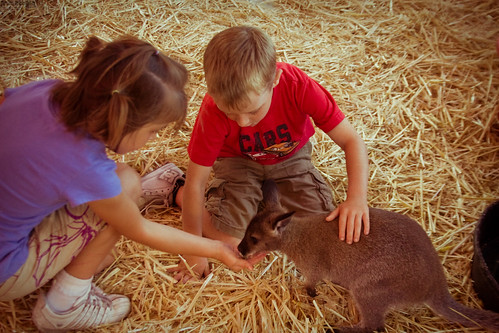Sugar Gliders are a trendy exotic pet from Australia. It is important to know more about Sugar Gliders as pets if you are thinking of getting one.
These marsupials are certainly cute, but not a pet we, at the cabin, have ever owned. Having spoken to many Sugar Glider owners, they are a very demanding exotic pet, and one that some people have felt was a mistake to get. Sugar Gliders are certainly
not pets for the first time owner, or a person who does not have a lot of time to spend with their pet.
Sadly, sugar gliders are often kept in cages that are far too small for a their needs; they also suffer if not kept with a companion, or not carried around for a good portion of the day (at which time they pee, and poop).
Another concern is the age at which Sugar Gliders are sold and purchased. Pet stores often sell retired breeding animals, in other words -
old stock, with breeders selling younger animals directly to the public for higher prices than the stores are willing to pay them (indeed stores buy cheap so they can resell high). It is very difficult to tell the age of a Sugar Glider so this is a common trick in the industry.
By Alessandro Di Grazia (
http://www.petsugargliders.eu/) [GFDL (
www.gnu.org/copyleft/fdl.html) or CC-BY-SA-3.0-2.5-2.0-1.0 (
www.creativecommons.org/licenses/by-sa/3.0)], via Wikimedia Commons
How To Care For A Sugar Glider
Feeding
Like
most exotic pets, Sugar Gliders do have specific dietary
requirements. They are very prone to problems with getting an
improper balance of calcium to phosphorous, which will contribute to
a bone disease. There for it is highly recommended you find a proper
food made for Sugar Gliders. Or supplement their diet with vitamins
and minerals. In an emergency you can give them good quality cat
food, fresh fruit, as well as calcium enriched crickets or chicken
eggs.
Housing and Care
Height
of the Sugar Glider cage is very important. They are one of the few
pets who actually prefer a taller cage to a long one. The cage
should be at least 3 feet high for a pair of gliders, and taller if
you are planning on housing more. The bars should not be more than ½
an inch apart or you will risk escape. You may house two same sexed
animals in a cage, which may be better than having a breeding pair.
If the cage is large enough you may have as many as four adult
animals in a cage.
As they love to climb, you must provide plenty
of opportunity to climb, ladders, ropes, and even bird toys are good
if you cannot find actual toys for sugar gliders. They do require a
place to sleep, which should be either a nest box or pouch. Because
they tend to urinate in their bed you may want to get 2 pouches, so
you can wash one and use the other. They may enjoy a wheel similar
to what is used for hamsters.
You
will want to line the bottom of the cage with newspaper and cover it
lightly with pine (not cedar) shavings. Of course you need to
supply a water source.
Other Information
As
mentioned, these are NOT pets for beginners. They require a lot of
social care. If you are only going to have one you must be able to
provide it with a lot of social interaction, such as carrying it in a
pouch for most of the day and evening. Remembering that Gliders are
not “neat” pets. They will urinate in the pouch. Punishing them
for a natural behavior is not fair. You cannot house train these
small, rather primitive animals. Likewise, because they are
climbers, and have sharp claws they should not be punished for
scratching you when they climb on you
They are nocturnal, which
means they will keep you awake at night if you plan to keep it in
your bedroom. They will live for 10-15 years, about as long as a
dog, are you prepared for this length of a commitment? Another
question to ask is do you have a knowledgeable veterinarian in your
area, who can provide care? If you are a person who likes to take
vacations, you need to be prepared to provide social care for your
Sugar Glider while you are away.
These
are not cheap pets and they have very special requirements. Getting
a pet should never be taken lightly, and this is especially true of
exotics like Sugar Gliders. I encourage you to do more research on
your own before getting a Sugar Glider (or any pet). Use multiple
sources and especially those from people with nothing to gain.
Somebody who is trying to sell you a pet has their income on the
line. They may not be totally honest about the work or expense
involved.
An
alternative pet would be a Rabbit or Guinea Pig. Both are awake in
the day, and so much is known about them that it is easier to find
good care for a sick animal. Neither are as demanding as Sugar
Gliders, and both come in some rarer forms. Good luck with your
selection of the right pet.






















